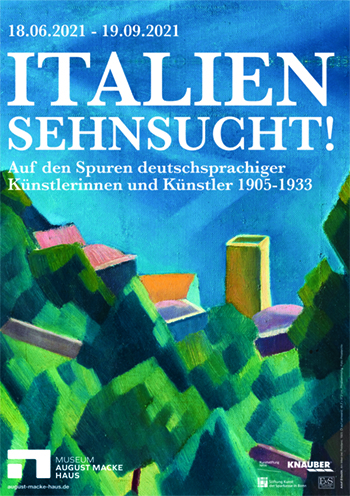LONGING FOR ITALY!
18.06.2021 – 19.09.2021
Italy – the cherished travel destination and embodiment of an arcadian paradise for „northerners,“ at the latest after Goethe‘s extended stay there (1786–88)! The sheer abundance of artworks in churches, palaces, and museums attracted culturally interested travelers as well as artists from around the world. Also important were the sunny climate, Mediterranean countryside, and „the good life.“ While Paris ascended to the rank of Europe‘s number-one art metropolis at the beginning of the 20th century, Italy remained a coveted travel destination for the younger generation of artists – especially if financed by a grant from the German-funded art establishments Villa Romana in Florence or Villa Massimo in Rome. These institutions were founded in 1905 and 1910 during the high point of Expressionism. Artists such as Karl Schmidt-Rottluff, Helmuth Macke, and Max Peiffer Watenphul arrived in Rome as grant-holders while Ernst Barlach, Max Beckmann, Dora Hitz, Hans Purrmann and others worked in Florence at the Villa Romana, which had been purchased by Max Klinger.
August Macke, Erich Heckel, Max Pechstein, and Walter Ophey toured through Italy on their own before the outbreak of the First World War. Wassily Kandinsky and Gabriele Münter spent treasured months together along the Ligurian coast. Other artist couples such as Gertrud Alber-Eberz with Josef Eberz and Maria Caspar-Filser with Karl Caspar explored the Italian countryside around Florence, along the Amalfi Coast, and in Umbria. In the early 1920s a lively artist colony developed in Positano. Settling there were, among others, Anita Rée, Carlo Mense, and Richard Seewald. Adolf Erbslöh painted heroic-dramatic landscapes in Positano – comparable to the monumental compositions of his friend Alexander Kanoldt. For Werner Gilles, Hans Kuhn, and Eduard Bargheer Italy became a home away from home.
For the first time our show focuses on the Italian travels of German artists between 1905 and 1933: Expressionist drama and New Objectivism – both dispositions may be found in the artists‘ dialogue with the country, its towns and places, people, countryside, and legends.
With some 100 paintings, works on paper, photographs, and sculptures done by 30 artists between 1905 and 1933, the exhibition impressively highlights Italy‘s importance for German avant-garde artists.
The show is curated by Martina Padberg and is a cooperative venture with the Museum im Kulturspeicher Würzburg and the Kunstsammlungen Zwickau – Max Pechstein Museum. An exhibition catalogue published by Wienand-Verlag may be purchased at the Museum‘s ticket desk for 19,90 €.
![[Translate to Englisch:] Rückschau](/assets/header/rueckschau_1.jpg)
